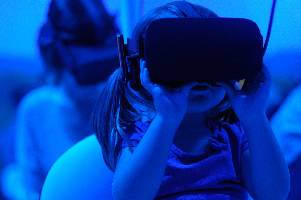Summary
This 120-minute professional development focuses on understanding how virtual reality (VR) can take teaching and learning to a higher level through real-world connections, 21st-century skills, and critical thinking. Participants will explore VR, and then use VR resources to create a lesson or classroom activity.
Essential Question
How does the use of virtual reality in the classroom help students create real-world connections?
Materials List
Access to devices and technology—computers/Chromebooks, internet, etc.
Access to Merge VR or Google Expedition headsets
Post-it notes
Stop and Jot note-catcher (attached)
I Used to Think...But Now I Know Handout (attached)
I Think...We Think Handout (attached)
5E Lesson Organizer (attached)
Authentic Lesson Reflection Tool (attached)
Learning Goals
Participate in a VR-enhanced lesson
Identify various VR-enhanced activities to use in a lesson
Create a VR-enhanced lesson to use in the classroom
Engage
Begin with slide 2, displaying the presentation title. Welcome all participants and introduce yourself and your background. Transition to slide 3 and slide 4 to display and discuss the learning objectives and essential question. Share with participants that allowing students to use various technology applications can possibly increase engagement, academic performance, and postsecondary education preparation.
Show slide 5 and introduce the I Think/We Think strategy. This strategy can be used to encourage learners to think about and list their individual ideas on a topic and to record common ideas that surface during group share-out discussion. Provide each participant with a post-it note. Then have them write, "I Think" on one side and "We Think" on the other. Ask learners, "How can integrating technology in the classroom engage students?" Allow time for participants to write their responses on the "I Think" side of the post-it note. Then ask participants to get with their group or table group and share recorded answers. Give time to allow them to record a response on the "We Think" side of the post-it note.
Explore
Using the Expeditions app, lead the participants on an expedition as if they are the student and you are the teacher.
Using the Stop and Jot strategy, allow participants to explore lessons to use VR in the classroom. This strategy allows participants to break down and analyze pieces of text. Using the links on slide 10, allow participants time to explore each resource and find lessons to use to create VR-enhanced learning activities.
After participants have found resources, use the strategy, Collective Brain Dump. This strategy allows participants to share with the whole group. On a Padlet, created prior to the session, have participants share great finds from all of the resources on slide 10 and other places.
Explain
Now using the 5E lesson model and resources on slide 10 and the Padlet, we will begin to create an activity or part of a lesson to use in your classroom.
Using the expedition you found, (instructions on slide 15), practice adding explorers (students) and walking through the expedition. Then develop an activity or part of a lesson that you could integrate with this expedition. When work time is over, transition to slide 16, and ask participants what else they might need to be successful in the use of immersive technology.
Extend
Move to slide 17, and have participants place their created activity or lesson in a group "Digital Gallery Walk" document. Gallery Walk/ Carousel is a learning strategy that can be easily facilitated online with a file-sharing platform such as Google Docs or Sharepoint, where student documents or works can be viewed and discussed by a group.
While participants browse the Digital Gallery, go to slide 18 and have participants consider the prompts, What other technologies could we integrate? and How could we make this activity more authentic? Facilitate a discussion and compare responses to the authentic reflection tool, as time allows.
Evaluate
To wrap up, transition to slide 19, and present the prompt for the I Used to Think..., But Now I Know strategy. This strategy can be a way to have participants think meta-cognitively about the experience they have undergone. In the first column, I Used to Think, have participants record something they previously thought about VR-enhanced lessons/activities. In the second, But Now I Know, have them write what they learned during this activity.
Transition to slide 20, and review the strategies used throughout this activity.
Follow-up Activities
After teachers have implemented VR-googles in the classroom, an opportunity exists for them to reflect upon their application. A discussion of how their implementation went, and what they might change if using this technology again should follow to support the continued use of immersive technology.
Research Rationale
As with all technological innovations, the teacher and the pedagogical strategies are more important than the technology (Salmon and Nyhane, 2013). In the context of English Language Arts, virtual reality and augmented reality technologies can be used to support students both through visual and experiential scaffolding, as well as by helping to build background knowledge about content (Pilgrim and Pilgrim, 2016). These technologies have been shown to improve student reading comprehension skills, perhaps because students find the technologies to be fun and motivational (Bursali and Yilmaz, 2019). To be effective, the tech must be combined with pedagogically sound, well-designed learning tasks (Hockly, 2019). Finally, the tech is most effectively integrated into the curriculum when teachers are involved in a collaborative design process for new lessons, or when they customize extant lessons based on stated learning goals (Patterson and Han, 2019).
Resources
K20 Center. (n.d.) I think/We think. Strategies. Retrieved from https://learn.k20center.ou.edu/strategy/141
K20 Center. (n.d.) Stop and jot. Strategies. Retrieved from https://learn.k20center.ou.edu/strategy/168
K20 Center. (n.d.) Collective brain dump. Strategies. Retrieved from https://learn.k20center.ou.edu/strategy/111
K20 Center. (n.d.) Gallery walk/Carousel. Strategies. Retrieved from https://learn.k20center.ou.edu/strategy/118
K20 Center. (n.d.) I used to think...But now I know. Strategies. Retrieved from hthttps://learn.k20center.ou.edu/strategy/118
Lesson Image Credit: Photo by Giu Vicente on Unsplash. Retrieved from https://unsplash.com/photos/FMArg2k3qOU


